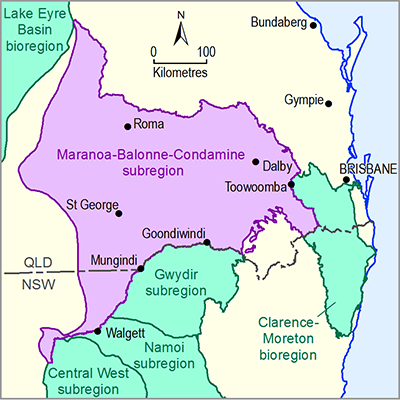A BA is a regional analysis that compares two futures of coal resource development. In BAs, the term ‘coal resource development’ specifically includes coal mining (both open-cut and underground) as well as CSG extraction. Other forms of coal-related development activity, such as underground coal gasification and microbial enhancement of gas resources, are not within the scope of BAs.
The two futures considered in the BA for the Maranoa-Balonne-Condamine subregion are:
- baseline coal resource development (baseline)[1]: a future that includes all coal mines that are commercially producing as of December 2012 and five CSG fields reported in the Annual report 2014 for the Surat underground water impact report (OGIA, 2014)
- coal resource development pathway (CRDP): a future that includes all coal mines and CSG fields that are in the baseline as well as those that are expected to begin commercial production after December 2012.
The five baseline open-cut coal mines in the subregion are Cameby Downs Mine, Commodore Mine, Kogan Creek Mine, New Acland Coal Mine Stage 2 and Wilkie Creek Mine (which ceased operations in December 2013). For this Assessment, the five baseline CSG fields (Australia Pacific Liquefied Natural Gas (LNG) Project, Santos Gladstone LNG Project, Queensland Curtis LNG Project, Surat Gas Project and Ironbark Project) are deemed to be in the BA baseline to ensure consistency with the CSG development profile reported in the Annual report 2014 for the Surat underground water impact report (OGIA, 2014). The OGIA model was the best available representation of CSG development in the Surat CMA when the CRDP was finalised in July 2015 (see companion product 2.3 for the Maranoa-Balonne-Condamine subregion (Holland et al., 2016)).
The difference in results between CRDP and baseline is the change that is primarily reported in a BA. This change is due to the additional coal resource development – all coal mines and CSG fields, including expansions of baseline operations, that are expected to begin commercial production after December 2012. In the Maranoa-Balonne-Condamine subregion these are the New Acland Coal Mine Stage 3 and The Range coal mine. Further details are provided in companion product 2.3 for the Maranoa-Balonne-Condamine subregion (Holland et al., 2016).
Although the difference in potential impacts between these two futures is of most concern, the potential impacts under the baseline are important for regional context. For instance, the potential implications to groundwater-dependent assets of an additional 2 m of drawdown may depend on whether the drawdown under the baseline is 0.05, 0.5 or even 50 m. Potentially important impacts due to coal resource development under the baseline may also occur in parts of the subregion that are not further affected by additional coal resource development, and so are given less attention in the assessment. Note that the year in which maximum drawdown occurs under each future is unlikely to coincide and that simply adding the drawdown results in a worst-case scenario that is unlikely to eventuate.
The CRDP is considered the most likely future, based on the analysis and expert judgment of the Assessment team in consultation with coal and gas industry representatives, state agencies and the Australian Government. The CRDP was finalised based on information available as of July 2015 (companion product 2.3 (Holland et al., 2016)). The reality is that the CRDP may ultimately be implemented in different ways (e.g. changes to timing) or circumstances of coal resource developments may even change (e.g. a proponent may withdraw for some reason). This reflects the dynamic nature of resource investment decision making, which may ultimately be impacted by diverse economic, political or social factors. Consequently, the CRDP needs to be viewed as an indicative future that highlights potential changes for water resources and water-dependent assets that may need to be considered further in local analyses or conditions. Equally as important, the CRDP plays a role in identifying where changes will not occur and thus flagging where potential impacts to water resources and water-dependent assets are very unlikely (less than 5% chance).
Factors such as climate change or land use (such as agriculture) are held constant between the two futures. Although the future climate and/or land use may differ from those assumed in BAs, the effect of this choice is likely to be small because the focus of BAs is on reporting the difference in results between the CRDP and baseline.

Product Finalisation date
- 3.1 Overview
- 3.2 Methods
- 3.3 Potential hydrological changes
- 3.4 Impacts on and risks to landscape classes
- 3.4.1 Overview
- 3.4.2 Landscape classes that are unlikely to be impacted
- 3.4.3 'Floodplain or lowland riverine (including non-GAB GDEs)' landscape group
- 3.4.4 'GAB GDEs (riverine, springs, floodplain or non-floodplain)' landscape group
- 3.4.5 'Non-floodplain or upland riverine (including non-GAB GDEs)' landscape group
- 3.4.6 'Human-modified' landscape group
- References
- Datasets
- 3.5 Impacts on and risks to water-dependent assets
- 3.6 Commentary for coal resource developments that are not modelled
- 3.7 Conclusion
- Citation
- Acknowledgements
- Contributors to the Technical Programme
- About this technical product
